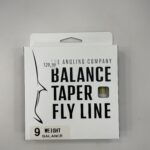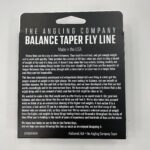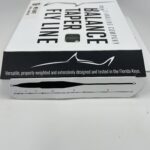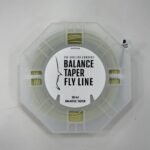Balance Taper Fly Line
It occurred to us when we made a line that we were in for a larger undertaking than we thought. After all, could we really bring something new to the table? Were we actually qualified to do more than criticize what we didn’t like, and instead create something we liked more? In a sport where all are entitled to an opinion, were we actually qualified?
These doubts informed our process, and in the end, gave us a line that we are proud of. We knew a few things that we didn’t like, and that was where we started. Lines that are too heavy in the front (some are a full line size heavier, or more) make the short casts easy, but the longer casts suffer. Trying to cast outside of 40 feet with a line that’s over-weighted is hard, and no one seems to bring this up. Lines that are light suffer from an opposite but no less debilitating characteristic: at the beginning of the cast, it’s nearly impossible to get any feel from the rod. Lines that suffer from one or the other of these afflictions seem to be everywhere. We felt that a line could have enough mass in the front to turn over a short cast, but also have enough distribution throughout the rest of the head and rear taper to make it easy to work with at longer distances. With the taper itself, our goal was the easy intersection between casting close and loading the rod and having control at longer distances.
The basic idea behind the line is pretty straightforward but takes some touch to understand. There are two things we talk about when we talk about lines: weight, and taper. These two attributes are often conflated because when you change the taper of a floating line you also change the weight. Lines that have short, compact heads tend to be heavy. Lines that have long rear tapers and longer heads are usually lighter. When we use these terms “heavy” and “light” we are talking about a relative weight—a “heavy” 8-weight fly line would, for example, be quite “light” for a 10-weight fly rod, though the taper might still be too heavy in the front to make it useful.
So, with this in mind, we imagined two separate silos when we were making this line. The first was a taper, and we have one that we adore. It has enough of a rear taper for control, and enough weight in the front to load the rod and shoot a longer delivery. We moved these things around, even after we found one we liked, to see if we could improve before settling on the final taper design. The second was weight: simply put, given the taper that we liked we started to ask how much weight should be in each size. This was what proved to be difficult, and to understand what we did and why requires a little explanation. Here goes.
If you were a line maker, I could hand you a line that I liked. Say it was a 9-weight. I could tell you that I wanted a full run of lines, and you would use the AFFTA standards to figure out what each of the other weights should weigh in the first 30 feet. If the 9 weighed 250 grains (at the upper end of the range for a 9-weight line), then the 10 would weigh in at 290, then 11 at 342, etc. Pretty easy, right? That’s what we thought.
The issue we had to solve didn’t come from line manufacturers—it came from the rod makers. Using the above example, I could bring you (now you’re a rod maker, congratulations!) a 9-weight rod that I liked. If I wanted a 10-weight or any other weight, there is no standard for what that rod should do. Without a measurement of the difference between two-rod weights, the process becomes one of trial-and-error, further informed/complicated by “feel”. Simply put, a 10-weight rod is one that throws a 10-weight line. And in today’s world where some folks try to get cute and over-weight a fly line and slap a sticker on the box, the rods have caught up with these heavy lines and are often stiffer than they “should” be to throw a line that is “properly” weighted to the AFFTA approved standards. What a mess.
In order to get our fingernails under this particular piece of vinyl, we had to understand something. Rods that are stiff can be painful to throw in the higher rod weights, but in smaller sizes, they’re a joy. By contrast, rods that are “soft” feeling can be great when they’re built as 11’s and 12’s, but in lighter weights, they can feel like a piece of moist fettuccini. Assuming that no rod manufacturer wants to be known as either a telephone pole or a pasta producer, this fact leads to something that we term an “unconscious slowing” of the rods in higher rod weights and the opposite in lower weights. The 9-weight seems to be the inflection point, above which we tend to perceive rods being heavy and below which we feel like they’re light. Consequently, rods above 9 are a tad slower than they should be, and rods below that are tightened up a bit—again, relative only to where they would be if there was a measurable stiffness scale. Which there isn’t. Le sigh.
In order to make our line as good as we could, we spent an equal amount of time thinking about the weight as we did taper. The taper was the easy part, in fact. Our target weight was where we think our work paid off and was the means by which we were able to get a line that we liked more than the rest of what was available. For lines above a 9, we subtracted the minimum amount of weight we could. The tolerance of the machinery helped here and was a blessing in disguise since without it we might still be working through micrograms in the prototype stage. What happens is that across the board the rods feel more familiar, more as they should. A ten feels like a stiffer, faster 9. The 11 is the same move again, retaining the feel and the ability to load the rod while still maintaining a lighter feel that often disappears when we’re tarpon fishing. When you throw an 8, you still have the ability to punch a cast into the wind, since there is a touch more weight in the head. On down to the seven, which with this line will be a great saltwater rod with the extra 10-15 grains of weight we added to lunch the lighter line into or across a stiff breeze.
This line is the product of not just contrary thinking, but proactive learning and producing. Instead of criticizing, we wanted to figure out our own solution to the problem. In a world of social media where everyone is a critic, we just wanted to make a line that solved problems instead of moaning about lines other people made. We’re proud of it, and the time we spent, and we believe you will like it as well.
These lines are available, for the time being, only through us. That will change in the future, we imagine, but for now, if you want one please call the shop (305-292-6306), email us, or shop online
Without a few key people, we wouldn’t have gotten very far, and these are they:
- Lawson Stiff, Esquire
- Captain Ian Slater
- Captain John O’Hearn
- Wes Smith, Esquire + American Hero
- Captain Brandon Cyr
- Captain Brian Helms
- Captain Chad Huff
- Captain Doug Kilpatrick
So that’s the story, as best as we can tell it here. We hope you enjoy the line we made as much as we enjoyed making it.
Nathaniel+Kat+Cody+Team





